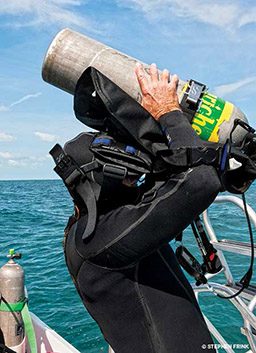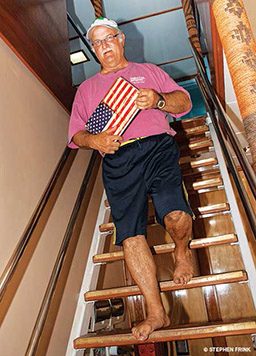In this article we continue the discussion about the role of the social context in diving begun in the Fall 2014 Expert Opinions article, “A Culture of Dive Safety.” Here, Dr. Jack Meintjes, an occupational medicine specialist who consults for diving (and other) companies on occupational health and safety issues, answers questions about the safety culture in recreational diving today.
Safety culture has been defined as the product of individual and group values, attitudes, competencies and patterns of behavior that determine the commitment to, and the style and proficiency of, an organization’s health and safety programs.

How would you define the culture of dive safety?
I like the definition “how people behave when no one is watching.” In diving we have to rely on a number of people for our health and safety. Many divers believe in good faith that the air provided to them by a dive operator meets safety requirements, that the boat operator will be there when they surface, etc. From experience, however, we know that this is not always true. I would like to see a tangible culture that is present when you engage with all persons involved in the operation.
Why is a safety culture important?
While most people are concerned about pressure-related illnesses and injuries, most incidents are not related to pressure. They range from falls on slippery surfaces to injuries resulting from poor practices or poor design. This is important to everyone: For dive operators, it involves legal and financial risk, including the risk of a bad reputation. The employees of the dive operator could be at risk of injury or illness, including illnesses that result from long-term exposure to risk factors present during the performance of their work. For divers who are clients of an “unsafe” operation, the risk of a ruined dive holiday and the associated medical and other costs is obvious.
Who is responsible for the culture of dive safety?
Everyone has a role to play. For example, you can look at any document that tries to regulate health and safety, whether it be formal legislation of a country or the health and safety policy of a company or institution. If properly designed, these documents will address the responsibilities of all persons who could possibly enter the premises and surroundings. It will not only address the managerial side of safety but also the roles of all employees, clients and even visitors. But we have to be on guard against the “if everyone is responsible, then no one is” mentality, so it’s important to assign responsibilities to specific people. While all of us have a responsibility, not everyone has the same responsibilities.

What are the key attributes of a sound safety culture?
The process starts with the identification of possible hazards (items or actions, or the lack thereof, that could lead to injury, illness or other losses). Once the hazards have been identified, each should be evaluated to determine the risk associated with it. Some hazards may have more than one risk — risk of injury may also have a risk of litigation, or certain chemicals may have a risk of liver damage, brain damage, skin rashes and even cancer. One should determine the risk for each of these outcomes. Once the risks are known and scored in a way that indicates the greatest risks in the institution, these can be addressed in a systematic manner. Addressing some risks requires engineering changes (e.g., changing the design of a ladder on a dive boat to prevent hand injuries), while addressing others requires administrative changes regarding rules, standard operating procedures, training, etc.
Last, the use of personal protective equipment should be considered — to address the risk of hearing loss in compressor operators, for example. When a system like this is implemented and actively managed, you will find that the risk scores (as measured) will decline. This in turn will lead to other risk factors receiving higher scores and thus needing to be addressed. What then happens is that the institution enters into a cycle of continual improvement in health and safety. If safe and healthy behaviors are rewarded they become ingrained in all individuals and become part of that organization’s culture. The key attributes are the identification of hazards, assessment of the risks associated with those hazards, mitigation of those risks in a systematic manner and continuous improvement over time.

How can we evaluate the safety awareness of divers?
We developed a program at DAN Southern Africa in collaboration with DAN Europe that is specific to the diving environment. We have used it successfully at a number of dive locations internationally, including some commercial dive operations, and have received only positive feedback. These operations then partner with DAN, and we assist them with expert advice (in occupational medicine, engineering, etc.) that could lead to improvement of their health and safety, while we also recognize their efforts by listing them as a Diving Safety Partner (DSP). Divers can then see who the safety-conscious operators are and dive with them.
The other consideration is the evaluation of safety awareness in divers, which we have not yet started. We make divers aware of the program, and we have published many articles on safety issues associated with diving operations, but we have not yet measured divers’ awareness of safety. My sense would be to first engage with our DAN members — both via our communications channels and out in the field.
What are the gaps in the dive safety culture today?
The gaps are in the knowledge of particular risks among dive operators and the lack of a structured approach to dive safety. Most people address the “obvious” risks, but these are not the ones causing the most incidents. Sometimes the warnings are there in the form of near misses. However, there are very few dive operators who measure and systematically evaluate incidents, let alone near misses.

What can be done about this, and who can do it?
DAN Southern Africa has started the process with the Hazard Identification and Risk Assessment (HIRA) program (see sidebar). Once the hazards and risks are known, the operators can start addressing them in a systematic manner. We also provide a framework in which these problems can be addressed and act as a resource center in this regard. However, we don’t force this approach, we offer it. The process is always initiated by the dive operators. We invite them to ask us for assistance and then engage with them upon request.
Since we have a passion for a culture of health and safety in diving, we are currently offering this service at no cost to recreational dive operators in our region. We want divers to come to expect a high level of safety and a culture of safety. This would then put unsafe operators out of business. In the end, everybody would meet their responsibilities for health and safety.
What are possible obstacles in advancing a culture of safety, and how can they be overcome?
Many people are simply not aware of existing safety standards. It’s often true that a dive operation can make cheap and easy changes that can have a dramatic impact on safety. It is thus important that we make the information available to everyone concerned. Unfortunately there are still a number of people who “have done it like this for years” and are not willing to change — they simply accept a high incident rate.
I think the power is in the hands of the client. When divers come to expect a healthy and safe dive (and all associated interactions), dive operators will have to provide such a service to survive.
HIRA Goals and Objectives
- To initiate and then grow participation by all diving service providers.
- To provide risk and safety awareness education to all participants.
- To offer risk mitigation and control education courses based on actual operational aspects.
- To have an accident and incident monitoring program in place to continually assess the status of progress toward the vision.
Typical Risk Areas
- ladders and stairs
- entries and exits, emergency escape routes
- boat propellers and boat operations
- slippery surfaces
- lifting of heavy equipment
- noise-induced hearing loss
- compressors, gas quality, cylinder filling, cleanliness
Source: DAN Southern Africa
Meet the Expert
W.A. “Jack” Meintjes, MBChB, DOM, FCPHM(SA) Occ Med, MMed (Occ Med), began his dive medicine career at the Institute for Maritime Medicine in Simon’s Town, South Africa, and is currently the medical advisor of the Department of Labour of South Africa. He is employed as the Head of the Unit for Infection Prevention and Control at Stellenbosch University and Tygerberg Academic Hospital and is the medical director of DAN Southern Africa. A passionate diver who has completed numerous recreational, commercial and military dives, Meintjes serves on a number of international diving medical bodies, including the European Diving Technology Committee and the Diving Medical Advisory Committee.
© Alert Diver — Q2 Spring 2015